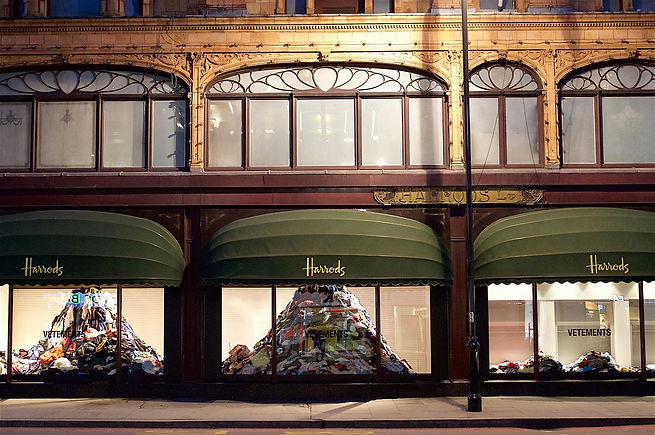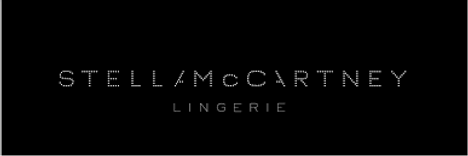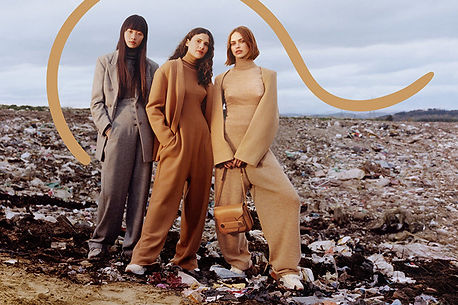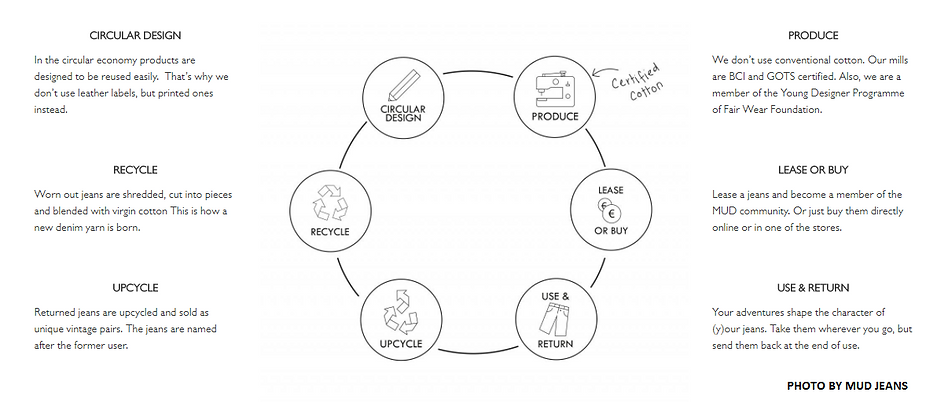SUSTAINABILITY & SLOW FASHION
Enjoy your sustainability and slow fashion trip
Fabscrap is a New York non-profit organization which is a specialty recycle store. It recycles scrap fabrics from famous brands such as Marc Jacobs, Oscar de la Renta and Eileen Fisher. Jessica Schreiber who is the founder of this store said that a total of 68,000 pounds of fabric was collected in 2017, and enough to fill 13,600 shopping bags. Fortunately, these fabrics have the opportunity to be used twice.
However, there are mass of overproduced clothing cannot escape the fate of abandonment.
In recent years, the rapid development of fast fashion promotes increasingly serious environmental issues so that more and more people pay their attention to the concept of slow fashion. Chasing the fashion trend indiscreetly is replaced by the quality of products.
What is slow fashion? Fletcher (2007) defines the phrase of ‘slow fashion’ that “The concept of slow fashion borrows heavily from the Slow Food Movement. Slow fashion is about designing, producing, consuming and living better. Slow fashion is not time-based but quality-based (which has some time components). Slow is not the opposite of fast – there is no dualism – but a different approach in which designers, buyers, retailers and consumers are more aware of the impacts of products on workers, communities and ecosystems.” In addition, Jung and Jin (2014) believe that "slow fashion is a broader concept than environmental sustainability alone, encompassing (1) caring for producers and local communities for sustainable life (equity and localism); (2) connoting history for sustainable perceived value of the product (authenticity); (3) seeking diversity for the sustainable fashions world (exclusivity); and (4) maximizing product lifespan and efficiency for a sustainable environment (functionality)."
There are three parts of this sustainability and slow fashion trip namely luxury brands, jeans companies and individual slow fashion studio. In the first section, you can see the attitude of fashion trendsetter, Vetements and STELLA McCARTNEY. These two brands highlight how important of slow and sustainability fashion in the evolution of fashion industry. They also have made slow and sustainability possible now. The next section is three jeans companies which are making efforts for sustainability and environmental conservation. You can see what kind of things that they did to achieve jeans sustainability. The last section is a slow fashion studio that the designer think working in slow fashion is an exciting and rewarding thing. Mostly member of fashion industry is making a contribution to achieving slow and sustainability fashion. Hoping this site could help every reader to increasing the understanding of slow fashion. Our team believe that it is a good chance to contribute to this common endeavor.
INTRODUCTION TO VETEMENTS
Vetements was founded by Demna Gvasalia and seven anonymous designers, the word of ‘vetements’ means ‘clothing’ in French. Why this new brand is able to be the trendy in the fashion industry very rapidly? Attitude and unique design are the core of this brand. The style of vetements could be grotesque, street, vintage, humorous, and even mad. In addition, the essence of the design is finding the most common elements in life, then deconstructing, analyzing, and recombining. After this kind of design method, the ordinary elements could be bold and interesting. The advantage of this way is making people feel remarkable and familiar. At first glance the tailoring of vetements may seem rough. However, the tailoring of clothing is surely accurate. If you move or change any detail of garment, you feel it will be much worse. The clothes from vetements is not only the attitude of unique, but also very durable and comfortable. This brand focus on quality, for example, there are only nine collections totally from 2014 to 2018 and the garments never repeating production. For instance, the collection of vetements in March of 2015, it is 70s and 80s hippie style that over the knee boots, oversize jacket, hoodie, stitching retro chiffon mop skirts are the popular items of this season. The next collection in August of 2015, the DHL logo tee shirt and orange hoodie are the most topical and fashion apparel in that time. This is the vetements’ approach to achieving slow fashion. Moreover, vetements would like to do some events to enhance people’s awareness of slow fashion via the brand’s influence and creativity such as the display with saks and maxfield in 2017. The following event is the newest recycle clothes exhibition that vetements cooperate with harrods from February 8 until March 2 in 2018.

Vetements is the most popular fashion brand in the top ten list which selected via the BoF in 2017, and this fashion brand promote the concept of slow fashion.
‘Quality over Quantity’ is the management philosophy of vetements.
The clothing of this brand is quite expensive such as a 600-pound sweatshirts, or a 1,200-pound pair of jeans, both of them made from recycled materials. Designer Gvasalia believes that all the stuff is limitation and high quality is the reason why the price is so expensive. Refusing crazy producing and making the fashion industry more slowly is what the brand has always insisted on.
PHOTO BY VETEMENTS
A PILE OF CLOTHES IN A WINDOW

OVER 30% OF MERCHANDISE PRODUCED BY FASHION BRANDS ARE NEVER SOLD AND END UP IN LANDFILLS.
- Vetements,via In Style
PHOTO BY VETEMENTS (2018)
VIDEO BY HARRODS (2018)
VETEMENTS' EVENTS
Vetements is a trademark in the fashion industry, and designer Demna Gvasalia has released his new project in the start of 2018 that a pile of recycle clothes displayed in Harrods' windows from February 8 until March 2. There are many media took part in this event. For example, VOGUE (2018) reports that “Over the past year, Vetements has been highlighting issues of overconsumption, staging waste-focused events at Maxfield in Los Angeles, Saks Fifth Avenue in New York, and Browns East in London. “But in this age, doing something once or twice isn’t enough. Our phone screens refresh so quickly that our attention spans have shrunk,” Gvasalia quips. He’s devoted the next twelve months to shining a light on the issue of overproduction with plans of fifty events worldwide starting with the windows at Harrods. Unveiled to the public this morning, they feature stockpile installations of clothes donated by Harrods’ four-thousand employees as well as original Parisian donation bins for charity, a regular occurrence on Instagram due to the "Vetements" logo featured on their fronts (simply meaning ‘clothes’). Throughout February, Harrods’ customers are invited to donate their own garments, the proceeds of which go to the NSPPC.” (http://www.vogue.co.uk/article/vetements-harrods-installation)
Moreover, i-D (2018) also reported that “The brand are embracing uber sustainability for their new Harrods display. The installation is the first of its kind in the UK, and one of up to 50 pop ups planned globally by Vetements this year. “In a fast world, the fashion tends to be fast too,” says Guram. “We like the idea of slowing down. We like the idea of slow fashion to buy less, buy quality and buy long-term.” Vetements explains that all the donations will go towards the NSPCC, but while it’s a step in the right direction to raise awareness of sustainability problems within fashion, it still seems in poor taste to display a mountain of clothes (undoubtedly expensive clothes) in the window of a luxury retailer during the coldest time of the year, when they could be donated, now, not later, to homeless charities…”
VETEMENTS 2017 EVENTS
PHOTO BY VETEMENTS
STELLA McCARTNEY

INTRODUCTION TO STELLA McCARTNEY
Stella McCartney's fashion is comfortable, attractive and modern. As she hopes, her designs will give women the feeling of strength and self-confidence. As her brand pay attention to slow fashion and innovative environmental design concept, she admired by peers and affects the entire fashion industry. In an interview from QQ fashion (2017), she stated that her inspiration comes from her perception of everything and people around herself. Any small thing can inspire her design. For example, the hair is now on the face, and the effect of the refraction under the sun can inspire my design, material color, and so on. Stella mccartney's design aims to balance fashion sense and practicality. Additionally, this brand has always been committed to creating designs that the garment will not be out of date, can be a permanent collection in the closet, and can even be saved to the next generation. Stella mccartney also tell customers her environmental design attitude via advertisement and charity activities.
Stella McCartney’s commitment to sustainability is evident throughout all her collections and is part of the brand’s ethos to being a responsible, honest, and modern company.
VIDEO BY STELLA McCARTNEY (2017)

PHOTO BY STELLA McCARTNEY (2017)

PHOTO BY STELLA McCARTNEY (2017)
Hokkfabrica (2017) reported that there is no bright color and natural beauty in Stella McCartney 2017 autumn and winter advertising such as blue sky and colorful background. However, the background of this advertising is actually a landfill and a pile of junk garbage. Why the brand choice this 'special' theme? The reason is that the brand would like to enhance the public’s awareness of environmental pollution which caused by waste in the fashion industry. As an influential brand, the raw material of 53% Stella McCartney's clothing is made from sustainable sources. Stella McCartney indicated we're wasting so much and we need to rethinking why this world obsessed with fast fashion. McCartney believed that fashion should be elegant, and it should express the attitude of love and beauty.
JEANS AND SUSTAINABILITY
INTRODUCTION
If one of the most popular items in the fashion industry, non-jeans is none other than. Jeans have become the most common basic garment of wardrobe. However, jeans are almost made of water. From cotton fields to cotton fabric to washing machines, a pair of jeans actually consumes 3,480 liters of water during their lifetime. If an adult need to two liters of water a day, the amount of water consumed by a pair of jeans can sufficient to satisfy an adult’s five years drinking water volume. Particularly, artificially created “done” effects of jeans, the heavy metals that can't be called or can't be named are the necessities to make jeans become fashionable. For every ton of denim products, it will pollute 200 tons of water. It's more intuitive to say that every kilogram produced is 3 jeans. The only way to pay for the desire to reduce costs is to be quality. If you want to buy a pair of jeans in 9.9 Euros, don't expect it to be a quality product. All following three jeans brand are the sustainability production. They use organic cotton and recycled cotton. Furthermore, they tell the customers how important about environmental fashion via their products brand’s influences. They also did lots of things to achieve sustainability of jeans so that the pollution and waste issues of jeans could be mitigated such as material, repair service, and recycling.
PHOTO BY MISENSE by Mila B
BRAND 1. MUD JEANS
DID YOU KNOW THAT FASHION IS THE SECOND MOST POLLUTING INDUSTRY IN THE WORLD?
READ MORE HERE
5 FACTS FORM MUD JEANS:
-
Producing one pair of jeans normally takes 7000 liters of water.
-
Each year 135 million kilos of clothing are burned in the Netherlands.
-
Fashion is the 2nd most polluting industry in the world.
-
Cotton growth accounts for 24% global insecticide sales.
-
Over 90% of textile waste in landfills is perfectly recyclable.

THE MUD WAY OF THINKING - CIRCULAR ECONOMY

PHOTO BY MUD JEANS

RETURN YOUR MUD JEANS FOR RECYCLING AFTER USE
AND GET A DISCOUNT OFF YOUR NEXT PAIR
KNOW MORE ABOUT THE BRAND
BRAND 2. NUDIE JEANS

PHOTO BY NUDIE JEANS
The product of NUDIE JEANS is made with:
-
100% organic cotton
-
social responsibility
-
transparent production
NUDIE JEANS strive for sustainable consumption patterns by:
-
offering free repair service
-
reselling second hand products
-
recycling worn out products
READ MORE ABOUT SUSTAINABILITY HERE
BRAND 3. HIUT DENIM

PHOTO BY HIUT DENIM
HIUT -
"There is a great deal of satisfaction to be gained from making something well, of such superior quality that you know it is going to stand the test of time. It makes the hard work and the obsessing over each and every detail worth all the effort. That’s our reward."
RULES OF THE NO WASH CLUB
1st Rule: Six months without washing means six months.
2nd Rule: No Cold dip in the bath.
3rd Rule: No showers.
4th Rule: Rain happens. Get an umbrella.
5th Rule: Freezing them is allowed.
6th Rule: Airing them on a washing line is allowed.
7th Rule: Rest days are allowed.
8th Rule: If you are going to try, go all the way.
THE INFORMATION FOR THE CLUB CAN BE FOUND HERE

MISENSE by Mila B is an independent slow fashion studio run by designer
and dressmaker Mila Burcikova. (MISENSE by Mila B, 2016)
INTERVIEW WITH MILA

PHOTO BY MISENSE by MILA B



SUMMARY OF INTERVIEW
The influential fashion brands take their social responsibility to improve the impact of slow and sustainability fashion to people so that the pollution and waste problems are able to alleviated. In addition, they contribute to development of slow fashion via their own attitude and design of everything products. The special cloths use specific methods to achieve slow fashion such as the jeans. There are also some independent slow fashion studios devoted so much to the development of slow fashion such as MISENSE by Mila B. As you can in the following interview, Mila Burcikova uses vintage materials mostly to make unique design clothing for her customers and shows her own attitude of fashion by her products. She stated in her studio’s website that “My designs are inspired by clothes that I love wearing myself feminine and comfortable, clothes in which you can forget what you are wearing and make the most of your day. My One Thing Collection consists of pieces designed to be worn every day across the seasons.” (MISENSE by Mila B, 2016)











